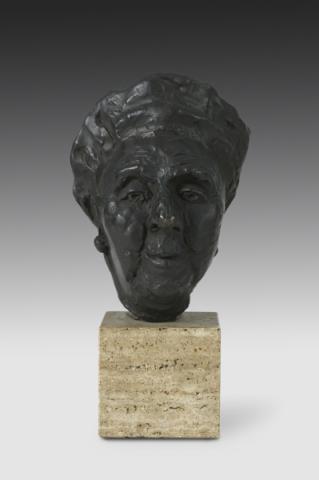Hermine Feist was married to the merchant and art lover Otto Feist who, after his death in 1912, left his collection of Old Masters, Italian furniture, small bronzes, majolica and stonework to their two sons Ernst and Hans. However, they left their mother, who herself was a passionate collector of porcelain, antique lace and jewellery, in charge of the collection. Feist's porcelain collection was considered to be one of the largest in Europe, with figurines, vases and tableware from the Meissen, Höchst, Frankenthal, Nymphenburg, Vienna, Ludwigsburg, Fulda and Limbach manufactories, which she presented in numerous display cases in the villa she inherited from her father, the industrialist Caesar Wollheim, founder and long-time owner of a coal wholesale business at Bergstrasse 5 at Wannsee. In 1914 and 1915, she donated a Viennese porcelain cup and a Nymphenburg porcelain figurine to the Berlin Palace Museum (later the Museum of Decorative Arts). Due to war loans, inflation and her lavish lifestyle, Hermine Feist no longer had any assets of her own shortly after the First World War and had to take out loans. She died in November 1933. To pay off her debts, parts of her collection were transferred to Dresdner Bank, which subsequently sold them to the Schlossmuseum Berlin in 1935. To cover their debts owed in their general partnership with Caesar Wollheim, Ernst and Hans Feist reached a settlement with Arnold Kunheim as the company's representative in October 1936, as a result of which six small bronzes worth RM 50,000 were transferred to their general partner Caesar Wollheim, who had them auctioned off by Hans W. Lange in June 1939. Among them was a bust of the Emperor from the 16th century, which was subsequently acquired by the Viennese art dealer Marianne Novakovic and subsequently sold to the Kunsthistorisches Museum (KHM) in June 1943.
Due to their Jewish origins, both sons were subjected to persecution during the National Socialist era: After Ernst Feist was arrested in connection with the November pogroms of 1938, he was deported to Sachsenhausen concentration camp. Although he was released only a few weeks later, he died shortly afterwards. Hans Feist emigrated to Switzerland at the beginning of 1940, where he lived as a freelance writer, while also giving lectures and translating. After 1945, Hermine Feist's heirs filed a claim for restitution, which resulted in the following settlement with the newly established Prussian Cultural Heritage Foundation on 8 December 1959: A small part of the art collection was restituted, but the majority was financially compensated, although not all objects were included in this settlement. The rest of the collection is still considered to have been destroyed or lost in the course of the war. At its meeting in May 2013, the Art Restitution Advisory Board spoke out against the restitution of the Emperor's Bust, now held by the KHM as a depiction of Hercules, as the debts incurred and the resulting sale by the Feist brothers had no connection with the Nazi takeover.

